Octet rule - Study guides, Class notes & Summaries
Looking for the best study guides, study notes and summaries about Octet rule? On this page you'll find 455 study documents about Octet rule.
Page 4 out of 455 results
Sort by
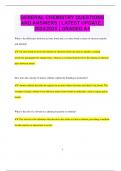
-
GENERAL CHEMISTRY QUESTIONS AND ANSWERS | LATEST UPDATE | 2024/2025 | GRADED A+
- Exam (elaborations) • 12 pages • 2024
- Available in package deal
-
 SterlingScores
SterlingScores
-
- $9.99
- + learn more
GENERAL CHEMISTRY QUESTIONS AND ANSWERS | LATEST UPDATE | 2024/2025 | GRADED A+ What is the difference between an ionic bond and a covalent bond in terms of electron transfer and sharing? An ionic bond involves the transfer of electrons from one atom to another, creating positively and negatively charged ions, whereas a covalent bond involves the sharing of electron pairs between atoms. How does the concept of atomic orbitals explain the bonding in molecules? Atomic orbitals des...
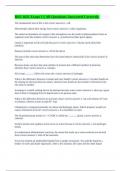
-
BIO 1021 Exam 1 || All Questions Answered Correctly.
- Exam (elaborations) • 11 pages • 2024
-
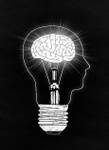 FullyFocus
FullyFocus
-
- $11.39
- + learn more
The fundamental unit of life is the correct answers e. cell. Heterotrophs obtain their energy from correct answers c. other organisms. The initial accumulation of oxygen in the atmosphere was the result of photosynthesis from an organism most like modern correct answers a. cyanobacteria (blue green algae). Ozone is important to life on Earth because it correct answers c. blocks much ultraviolet radiation. Eukarya include correct answers e. All of the above The part of the atom tha...
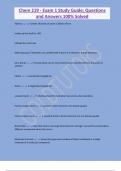
-
Chem 219 - Exam 1 Study Guide; Questions and Answers 100% Solved
- Exam (elaborations) • 6 pages • 2024
- Available in package deal
-
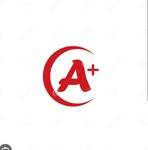 GOLDTUTORS
GOLDTUTORS
-
- $11.99
- + learn more
Chem 219 - Exam 1 Study Guide; Questions and Answers 100% Solved Valence number of bonds an atom is likely to form makes up the shell for LDD Follows the octet rule Main 8 groups of elements are satisfied with 4 pairs of 2 electrons; 8 total electrons Ionic Bonds Formed when one or more electrons are transferred from one atom to another Cation A positively charged ion Anion A negatively charged ion covalent bond A chemical bond formed when two atoms share electrons Purely covalent ...
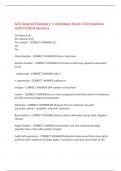
-
ACS General Chemistry 1 studysheet Exam 124 Questions with Verified Answers,100% CORRECT
- Exam (elaborations) • 10 pages • 2024
-
 paulhans
paulhans
-
- $11.99
- + learn more
ACS General Chemistry 1 studysheet Exam 124 Questions with Verified Answers 56=Mass # (A) 26= Atomic # (Z) Fe= symbol - CORRECT ANSWER 56= 26= Fe= Mass Number - CORRECT ANSWER Proton+ Neutrons Atomic Number - CORRECT ANSWER # of protons/electrons (equal in elemental form) - superscript - CORRECT ANSWER Add e- + superscript - CORRECT ANSWER subtract e- Isotope - CORRECT ANSWER Diff number of neutrons Isomer - CORRECT ANSWER two or more compounds with the same # of elemen...

-
UTK CHEM122 EXAM 2 QUESTIONS WITH 100% GUARANTEED PASS (LATEST 2024-2025 UPDATES)
- Exam (elaborations) • 6 pages • 2024
- Available in package deal
-
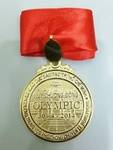 wisdompoint
wisdompoint
-
- $12.79
- + learn more
UTK CHEM122 EXAM 2 QUESTIONS WITH 100% GUARANTEED PASS (LATEST UPDATES) What determines the polarity of a molecule? - Answer-Electronegativity Octet Rule - Answer-When forming compounds, atoms tend to achieve the electron configuration of a noble gas (8 electrons) Duet Rule - Answer-Hydrogen and Helium only want two electrons Nonpolar Covalent Bond - Answer-Equal sharing of electrons Polar Covalent Bond - Answer-Unequal sharing of electrons Ionic Bond - Answer-Giving or taking ...
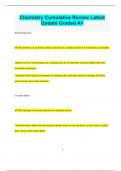
-
Chemistry Cumulative Review Latest Update Graded A+
- Exam (elaborations) • 7 pages • 2024
- Available in package deal
-
 ExcellentScores
ExcellentScores
-
- $9.99
- + learn more
Chemistry Cumulative Review Latest Update Graded A+ Electronegativity The tendency of an atom to attract electrons in a chemical bond. It is not directly measurable. Metals have low electronegativity, meaning they do not hold onto electrons tightly and often lose them in reactions. Nonmetals have high electronegativity, meaning they hold onto electrons strongly and often gain electrons from other elements. Covalent Bond The sharing of electrons between two nonmetal atoms. ...
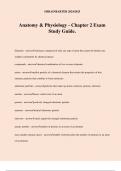
-
Anatomy & Physiology - Chapter 2 Exam Study Guide.
- Exam (elaborations) • 10 pages • 2024
-
 Brainbarter
Brainbarter
-
- $11.49
- + learn more
Anatomy & Physiology - Chapter 2 Exam Study Guide. Elements - answersubstance composed of only one type of atom that cannot be broken into simpler constituents by chemical means compounds - answerchemical combination of two or more elements atoms - answersmallest particle of a chemical element that retains the properties of that element; particles that combine to form molecules subatomic particles - answerparticles that make up atoms; neutrons, protons, electrons nucleus - answerdense, c...
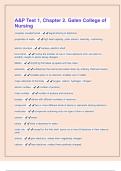
-
A&P Test 1, Chapter 2. Galen College of Nursing All Possible Questions and Answers 2025
- Exam (elaborations) • 4 pages • 2024
- Available in package deal
-
 ACADEMICMATERIALS
ACADEMICMATERIALS
-
- $7.99
- + learn more
nonpolar covalent bond - ️️equal sharing of electrons properties of water - ️️high heat capacity, polar solvent, reactivity, cushioning atomic structure - ️️nucleus, electron shell ionic bond - ️️involve the transfer of one or more electrons from one atom to another; results in atoms being charged Matter - ️️Anything that takes up space and has mass elements - ️️substances that cannot be broken down by ordinary chemical means atoms - ️️smallest piece of an elem...
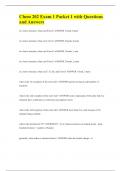
-
Chem 202 Exam 1 Packet 1 with Questions and Answers
- Exam (elaborations) • 4 pages • 2024
- Available in package deal
-
 wangithiannaw
wangithiannaw
-
- $7.99
- + learn more
Chem 202 Exam 1 Packet 1 with Questions and Answers in a lewis structure, what can H have? ANSWER 1 bond, 0 pairs in a lewis structure, what can C have? ANSWER 4 bonds, 0 pairs in a lewis structure, what can N have? ANSWER 3 bonds, 1 pair in a lewis structure, what can O have? ANSWER 2 bonds, 2 pairs in a lewis structure, what can F, Cl, Br, and I have? ANSWER 1 bond, 3 pairs what is the 1st exception of the octet rule? ANSWER species having an odd number of electrons what i...
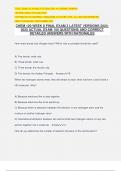
-
CHEM 120 WEEK 8 FINAL EXAM 2 LATEST VERSIONS 2024- 2025 ACTUAL EXAM 150 QUESTIONS AND CORRECT DETAILED ANSWERS WITH RATIONALES
- Exam (elaborations) • 54 pages • 2024
-
 EmillyCharlotte
EmillyCharlotte
-
- $11.49
- + learn more
CHEM 120 WEEK 8 FINAL EXAM 2 LATEST VERSIONS 2024- 2025 ACTUAL EXAM 150 QUESTIONS AND CORRECT DETAILED ANSWERS WITH RATIONALES How many bonds can nitrogen have? Which rule or principle should be used? A) Five bonds; octet rule. B) Three bonds; octet rule. C) Three bonds; the Hund's rule. D) Five bonds; the Aufbau Principle. - Answer️️ -B When two hydrogen atoms meet, they will attract to each other and form a bond (and a H2 molecule). Why? A) Because electrons like to stay togethe...

$6.50 for your textbook summary multiplied by 100 fellow students... Do the math: that's a lot of money! Don't be a thief of your own wallet and start uploading yours now. Discover all about earning on Stuvia


